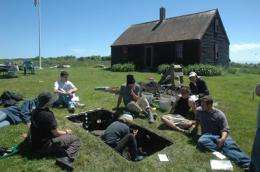Prehistoric tools discovered at Isles of Shoals

(PhysOrg.com) -- Summer students in Cornell's new Archaeology Field School at Shoals Marine Laboratory, Cornell's marine field station, have discovered the first prehistoric archaeological site in the Isles of Shoals, six miles off the Maine and New Hampshire coast.
The discovery, made earlier this month on Smuttynose Island, Maine, includes several stone tools and other artifacts. Although historians had long suspected that Native Americans had visited the isles, the artifacts now provide strong evidence that Indians inhabited the rocky isles around 800-1200 A.D. This is considered prehistoric because it was before any Native American written records and some 500 years prior to any European presence in the region, said Nathan Hamilton, director of the Archaeology Field School and a professor at the University of Southern Maine.
"This is a special discovery," said Robin Hadlock Seeley, assistant director of the Shoals Marine Laboratory and co-director of the Isles of Shoals archaeology project. "We always suspected that native peoples may have stopped at the Shoals before the 17th-century fishing station was established, but now we have clear evidence for their presence."
Hamilton documented several stone tools (arrow points, knives and scrapers) that were recovered, along with stone flakes from tool manufacture, ceramics and fire-cracked rock. The artifacts were dated based on their artifact styles, which include a Levanna point, a side-notched point and a stemmed point.
The excavations produce sufficient evidence to officially designate the site; an application will be filed with the Maine Historic Preservation Commission in coming months, says Seeley. The site will be known as the Hubbard-Oberlander site, an archaeological tradition of naming sites after the land owners.
"Archaeological studies on Smuttynose Island go hand-in-hand with ongoing investigations on the historical ecology of the Isles of Shoals," said William E. Bemis, director of Shoals Marine Lab. "As we build a better picture of human habitation of the islands, we can better understand the context for ongoing ecological change in marine and terrestrial environments."
The Isles of Shoals are most famous for the colonial fishing station that existed in the 17th to 19th centuries on Smuttynose Island and whose origin predated the arrival of Puritans to Massachusetts. Adjacent Appledore Island is home to Shoals Marine Laboratory, the base for the archaeological project on Smuttynose.
Provided by Cornell University (news : web)

















